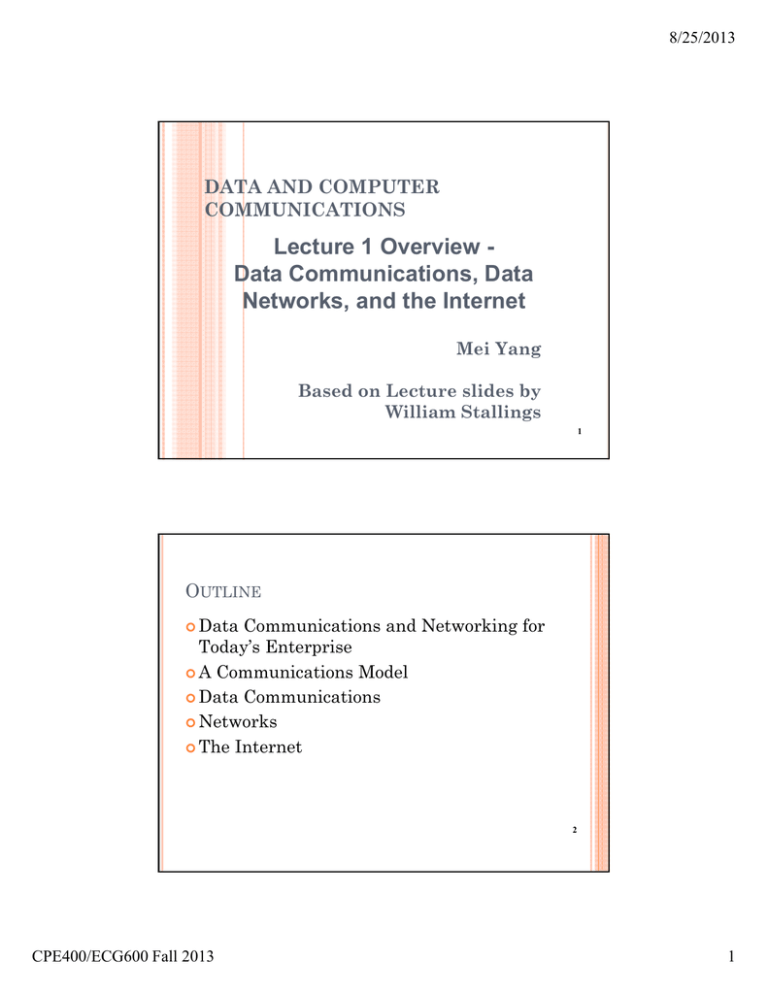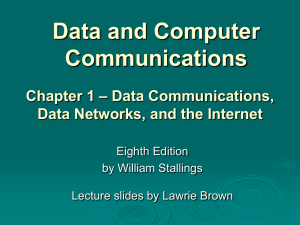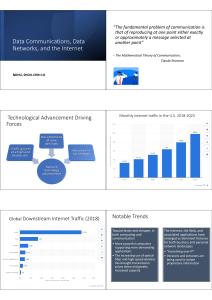Lecture 1 Overview - Data Communications, Data Networks, and the
advertisement

8/25/2013 DATA AND COMPUTER COMMUNICATIONS Lecture 1 Overview Data Communications, Data Networks, and the Internet Mei Yang Based on Lecture slides by William Stallings 1 OUTLINE | Data Communications and Networking for Today’s Enterprise | A Communications Model | Data Communications | Networks | The Internet 2 CPE400/ECG600 Fall 2013 1 8/25/2013 DATA COMMUNICATIONS AND NETWORKING FOR TODAY’S ENTERPRISE | Trends y Three forces that drive the architecture and evolution of data communications and networking Traffic growth at a high & steady rate •Development of new services •Advances in technology 3 4 CPE400/ECG600 Fall 2013 2 8/25/2013 TECHNOLOGY TRENDS | Four technology trends are particularly notable: y y y y The trend toward faster and cheaper, both in computing and communications, continues Both voice-oriented telecommunications networks and data networks are more “intelligent” than ever The Internet, the Web, and associated applications have emerged as dominant features of both business and personal world There have been a trend toward ever-increasing5 mobility for decades TECHNOLOGY TRENDS (CONT’D) 6 CPE400/ECG600 Fall 2013 3 8/25/2013 SIGNIFICANT CHANGES IN REQUIREMENTS | Emergence y Examples: centralized server farms, power workgroups, and high-speed local backbone | Corporate y of high-speed LANs WAN needs Driven by the needs of centralized data processing model and distribution of multiple offices. | Digital electronics 7 CONVERGENCE | The merger of previously distinct telephony and information technologies and markets | Layers: • applications | these are seen by the end users • enterprise services | services the information network supplies to support applications • infrastructure | communication links available to the enterprise 8 CPE400/ECG600 Fall 2013 4 8/25/2013 CONVERGENCE LAYERS 9 BENEFITS | Convergence benefits include: Efficiency Effectiveness Transformation • better use of existing resources, and implementation of centralized capacity planning, asset and policy management • the converged environment provides users with flexibility, rapid standardized service deployment and enhanced remote connectivity and mobility • enables the enterprise-wide adoption of global standards and associated service levels CPE400/ECG600 Fall 2013 10 5 8/25/2013 A COMMUNICATIONS MODEL 11 COMMUNICATIONS TASKS Transmission system utilization Addressing Interfacing Routing Signal generation Recovery Synchronization Message formatting Exchange management Security Error detection and correction Network management Flow control CPE400/ECG600 Fall 2013 12 6 8/25/2013 DATA COMMUNICATIONS MODEL 13 Transmission Lines | The basic building block of any communications facility is the transmission line. | The business manager is concerned with a facility providing the required capacity, with acceptable reliability, at minimum cost. CPE400/ECG600 Fall 2013 Capacity Reliabilit y Cost Transmission Line 14 7 8/25/2013 TRANSMISSION MEDIUM | selection y y is a basic choice internal use entirely up to business long-distance links made by carrier | rapid technology advances change mix y fiber optic y wireless 15 NETWORKING | growth of number & power of computers is driving need for interconnection | also seeing rapid integration of voice, data, image & video technologies | two broad categories of communications networks: y y Local Area Network (LAN) Wide Area Network (WAN) 16 CPE400/ECG600 Fall 2013 8 8/25/2013 WIDE AREA NETWORKS | span a large geographical area | cross public rights of way | rely in part on common carrier circuits | alternative technologies used include: y y y y leased line circuit switching packet switching: X.25, frame relay Asynchronous Transfer Mode (ATM) 17 18 CPE400/ECG600 Fall 2013 9 8/25/2013 CIRCUIT SWITCHING | uses a dedicated communications path established for duration of conversation | comprising a sequence of physical links | with a dedicated logical channel | e.g. telephone network 19 PACKET SWITCHING | data sent out in sequence of small chunks (packets) | packets passed from node to node between source and destination | used for terminal to computer and computer to computer communications 20 CPE400/ECG600 Fall 2013 10 8/25/2013 FRAME RELAY | Motivation y y packet switching systems have large overheads to compensate for errors modern systems are more reliable, errors can be caught in end system | Frame y Relay provides higher speeds with most error control overhead removed, up to 2Mbps 21 ASYNCHRONOUS TRANSFER MODE | evolution of frame relay and circuit switching y y y y fixed packet (called cell) length via virtual channels with little overhead for error control bandwidth from 10Mbps to Gbps constant data rate using packet switching technique with multiple virtual circuits 22 CPE400/ECG600 Fall 2013 11 8/25/2013 LOCAL AREA NETWORKS (LAN) 23 METROPOLITAN AREA NETWORKS (MAN) 24 CPE400/ECG600 Fall 2013 12 8/25/2013 THE INTERNET | Internet y y y y evolved from ARPANET first operational packet network applied to tactical radio & satellite nets also had a need for interoperability led to standardized TCP/IP protocols 25 INTERNET ELEMENTS 26 CPE400/ECG600 Fall 2013 13 8/25/2013 INTERNET ARCHITECTURE 27 EXAMPLE CONFIGURATION 28 CPE400/ECG600 Fall 2013 14 8/25/2013 SUMMARY | Trends y y y challenging data communications: traffic growth development of new services advances in technology | Transmission y y fiber optic wireless | Network y y mediums categories: WAN LAN | Internet y y CPE400/ECG600 Fall 2013 evolved from the ARPANET TCP/IP foundation 29 15


![Network Technologies [Opens in New Window]](http://s3.studylib.net/store/data/008490270_1-05a3da0fef2a198f06a57f4aa6e2cfe7-300x300.png)


